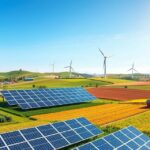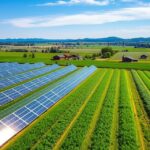The global renewable energy inverter market is set to hit $23.4 billion by 2027. This growth shows how vital cost-effective inverters are in changing solar power use.
Affordable inverters make solar power more accessible to homes and businesses. These devices turn DC electricity from solar panels into usable AC electricity.
Solar power inverters have become more advanced over time. They now offer smart solutions that boost energy efficiency and cut system costs.
Homeowners can choose from various cost-effective inverters to get the most from their renewable energy investments. The market for these inverters keeps growing.
Technological progress and rising demand for green energy drive this expansion. Consumers can pick from string inverters to microinverters, balancing performance and cost.
This guide will explore the best value inverters in the renewable energy market. It aims to help you make a smart choice for your solar energy setup.

Introduction to Cost-Effective Inverters
Renewable energy systems have changed how we make and use electricity. Inverters are key in these systems. They turn solar power into usable electricity for homes and businesses.
These devices are vital for sustainable energy solutions. They make renewable energy practical for everyday use.
Importance of Inverters in Renewable Energy
Inverters are essential in photovoltaic systems. They change direct current (DC) from solar panels into alternating current (AC).
This AC power runs our everyday appliances. Without inverters, solar energy wouldn’t work for most electrical devices.
- Convert solar panel DC output to AC power
- Enable grid connection for solar installations
- Maximize energy system performance
- Provide monitoring and safety features
Overview of Cost-Effectiveness
Choosing the right inverter involves more than just tech specs. It’s about balancing upfront costs with long-term benefits.
Modern inverters cut electricity costs and support sustainable energy. They’re a key part of making renewable energy more accessible.
“The right inverter can transform solar potential into economic opportunity.” – Solar Energy Industry Expert
People now see that good inverters offer big economic and environmental gains. These devices are crucial for affordable renewable energy.
Types of Inverters for Renewable Energy Systems
Solar power inverters transform solar energy into usable electricity for homes and businesses. They’re essential for renewable energy systems. Understanding inverter types helps in making informed decisions about solar setups.
Renewable energy systems use three main inverter technologies. Each has its own features and uses. Let’s explore these options.
String Inverters
String inverters are common in residential solar installations. They connect multiple solar panels in a series. These inverters change DC electricity to AC for home use.
- Most cost-effective option for uniform solar panel layouts
- Suitable for roofs with consistent sun exposure
- Simpler installation process
Microinverters
Microinverters offer a more advanced approach to solar power conversion. Unlike string inverters, these small devices are attached to individual solar panels. They provide several performance benefits.
- Enhanced energy production for partially shaded installations
- Individual panel monitoring capabilities
- Improved system reliability
Power Optimizers
Power optimizers blend string and microinverter features. They work well for off-grid and grid-connected systems. These devices optimize each panel’s output while using a central inverter.
- Maximize energy output for complex roof configurations
- Provide panel-level performance tracking
- More affordable than full microinverter systems
“Choosing the right inverter technology can significantly impact your solar energy system’s overall efficiency and performance.” – Solar Energy Expert
Factors Influencing Inverter Costs
Choosing cost-effective inverters requires understanding several key factors. These factors affect pricing and performance. Careful evaluation helps make informed decisions about energy-efficient technology investments.
Brand Reputation Dynamics
Established manufacturers often charge more for their cost-effective inverters. They invest heavily in research, development, and quality control. These investments directly impact product pricing.
- Proven manufacturing history
- Research and innovation investments
- Market credibility
Efficiency Ratings Impact
Energy-efficient technology determines an inverter’s overall value. Higher efficiency ratings mean better performance and potential long-term savings. However, these inverters may have higher upfront costs.
“Efficiency isn’t expensive—it’s an investment in future energy performance.”
Warranty and Support Considerations
Comprehensive warranties play a crucial role in inverter pricing. Longer warranties often indicate superior product quality. Robust customer support networks show manufacturer confidence.
- Standard warranty duration
- Extended warranty options
- Technical support accessibility
Carefully weighing these factors helps consumers select inverters that balance initial investment with long-term performance and reliability.
Top Affordable Inverter Brands in the U.S.
Choosing the right solar power inverters is key for renewable energy systems. U.S. manufacturers offer affordable inverters for homes and businesses. These brands have made renewable energy more accessible with cost-effective solutions.
Enphase Energy: Microinverter Innovation
Enphase Energy leads in affordable inverters with its microinverter technology. Their approach offers unique benefits for solar systems.
- Enhanced system performance
- Individual panel optimization
- Simplified monitoring through mobile apps
SMA Solar Technology: German Engineering Excellence
SMA Solar Technology brings robust inverters to the U.S. market. Their products offer great value with impressive features.
- High-efficiency conversion rates
- Comprehensive warranty options
- Versatile renewable energy systems compatibility
SolarEdge Technologies: Smart Inverter Solutions
SolarEdge Technologies balances performance and affordability in their inverter solutions. They excel in several key areas.
- Advanced power optimization
- Comprehensive system monitoring
- Cost-effective design for various solar installations
| Brand | Key Feature | Price Range |
|---|---|---|
| Enphase Energy | Microinverter Technology | $150-$300 per unit |
| SMA Solar Technology | High-Efficiency Conversion | $200-$500 per unit |
| SolarEdge Technologies | Smart Power Optimization | $180-$400 per unit |
“The future of renewable energy lies in affordable, efficient inverter technologies that make solar power accessible to everyone.” – Solar Industry Expert
Comparing Cost-Effective Inverters
Choosing the right inverter for solar systems requires careful analysis. Energy-efficient technology has changed how homeowners approach solar investments. Cost-effectiveness is now a key factor in decision-making.
Performance vs. Price Analysis
Inverter selection goes beyond initial cost. Top performers balance efficiency with affordability. Key considerations include conversion efficiency rates and power output capabilities.
Durability, reliability, and manufacturer reputation are also important factors to consider.
- Conversion efficiency rates
- Power output capabilities
- Durability and reliability
- Manufacturer reputation
Long-Term Savings Potential
High-quality inverters can significantly reduce overall energy expenses. Cost-effective models often provide substantial returns through:
- Reduced electricity bills
- Lower maintenance costs
- Extended system lifespan
- Enhanced energy production
Installation Considerations
“The right inverter can make or break your solar investment.” – Solar Energy Expert
Installation complexity directly impacts total system cost. Homeowners should evaluate compatibility with existing electrical systems and mounting requirements.
Professional installation fees and warranty coverage are also important factors to consider.
- Compatibility with existing electrical systems
- Mounting requirements
- Professional installation fees
- Warranty coverage
Choosing an inverter means balancing upfront costs with long-term performance. Smart investors focus on energy-efficient technology that delivers consistent, reliable results.
Benefits of Using Affordable Inverters
Affordable inverters are making renewable energy systems more accessible. These components offer major advantages for homeowners and businesses. They’re transforming sustainable energy solutions in remarkable ways.
Lower Initial Investment
Cost-effective inverters reduce the financial barrier to renewable energy systems. Homeowners can now invest in solar technology without huge upfront costs. This makes sustainable energy more appealing to a wider range of consumers.
- Decreased equipment costs
- More affordable installation
- Quicker return on investment
Increased Accessibility to Solar Energy
Budget-friendly inverters make solar technology available to more people. Small businesses and residential customers can now easily integrate solar solutions into their energy infrastructure.
“Affordable inverters are the key to making solar energy a realistic option for everyone.” – Clean Energy Expert
Environmental Impact
Affordable inverters help more people adopt clean energy. This leads to significant environmental benefits. It reduces carbon emissions and dependence on fossil fuel-based electricity.
- Lower carbon footprint
- Reduced greenhouse gas emissions
- Support for sustainable infrastructure
How to Choose the Right Inverter
Picking the best inverter for your renewable energy system is crucial. It affects your solar installation’s performance and efficiency. The right choice can save you money in the long run.
Your inverter choice impacts your system’s cost-effectiveness. Consider multiple factors to make the best decision for your needs.
Assessing Energy Needs
Know your energy needs before selecting an inverter. Different solar setups require unique inverter configurations.
- Calculate total daily energy consumption
- Evaluate peak power requirements
- Consider future energy expansion plans
Understanding Types of Solar Setups
Your solar system configuration determines the best inverter for you. Consider these options:
| Inverter Type | Best For | Key Characteristics |
|---|---|---|
| Grid-tied inverters | Homes with consistent utility connection | Lower cost, direct grid interaction |
| Off-grid inverters | Remote locations, independent power systems | Battery integration, standalone operation |
| Battery backup inverters | Areas with unreliable power grid | Emergency power, energy storage capabilities |
Evaluating Local Regulations
Local rules can affect your inverter choice. Keep these factors in mind:
- Utility interconnection requirements
- Permissible inverter types
- Grid connection standards
“The right inverter transforms solar potential into practical, reliable energy.” – Solar Energy Expert
Analyze your energy needs carefully. Understand different inverter types and local rules. This helps you make a smart choice for your renewable energy system.
Your decision can boost efficiency and save money. Choose wisely to get the most from your solar setup.
Maintenance Tips for Inverters
Proper care of solar power inverters ensures peak performance and longevity. It can extend your solar energy system’s life and maximize its potential. Regular maintenance is key to keeping your energy-efficient technology running smoothly.

Solar inverters are crucial in renewable energy systems. They convert DC electricity from solar panels into usable AC electricity. Understanding their upkeep is vital for homeowners and solar enthusiasts.
Regular Inspections
Routine checks keep solar power inverters in top shape. Experts suggest professional inspections once a year. These check-ups are essential for optimal performance.
During inspections, technicians will examine electrical connections and verify system performance. They’ll also spot potential wear and tear and ensure safety features work correctly.
- Check electrical connections
- Verify system performance
- Identify potential wear and tear
- Ensure safety mechanisms are functioning
Cleaning Procedures
A clean inverter environment prevents performance issues. Follow these steps to keep your inverter in good condition:
- Remove dust and debris from inverter surfaces
- Check ventilation areas for blockages
- Use soft, dry cloths for gentle cleaning
- Avoid liquid cleaners near electrical components
Monitoring Performance
Smart monitoring systems allow real-time performance tracking. These tools help spot potential issues early on. They’re a key part of modern energy-efficient technology.
| Monitoring Method | Benefits |
|---|---|
| Mobile App Tracking | Real-time performance updates |
| Web-based Platforms | Comprehensive system analysis |
| Professional Diagnostic Tools | Detailed technical assessments |
“Consistent maintenance is the key to maximizing your solar inverter’s efficiency and lifespan.” – Solar Energy Professionals Association
Future Trends in Inverter Technology
Inverter technology leads sustainable energy solutions. New innovations are changing how we use solar power. These changes make renewable energy more accessible and efficient.
Inverters are key in renewable energy systems. They’re evolving rapidly, transforming solar power capture and management.
Smart Inverters: The Next Generation
Smart inverters are a big step forward in renewable energy. They do more than just convert power. These devices have advanced communication and grid management abilities.
Smart inverters can adjust to grid conditions automatically. They provide real-time data on performance. This enhances system reliability for homes and businesses using solar power.
Energy Storage Integration
New inverter designs focus on working with battery storage. Companies like Tesla and SolarEdge are creating advanced inverters. These manage energy flow between solar panels, batteries, and home electrical systems.
This breakthrough helps homeowners use more renewable energy. It reduces dependence on the power grid. It also creates more resilient energy solutions.
Efficiency and Cost-Effectiveness Advances
Future inverter technology aims to cut costs and boost performance. Researchers are looking into new materials and cooling methods. These could greatly improve inverter efficiency.
These innovations will make renewable energy systems more affordable. They’ll attract more consumers to clean energy. This will speed up the shift to sustainable power.
FAQ
What is an inverter in a renewable energy system?
An inverter is a key part of renewable energy systems. It changes DC electricity from solar panels into AC electricity for homes and businesses. This device bridges the gap between solar energy production and usable power.
How do I choose a cost-effective inverter for my solar system?
To pick a cost-effective inverter, look at system size, energy efficiency, and warranty. Check performance ratings and compatibility with your solar setup. Compare brands like Enphase Energy, SMA Solar Technology, and SolarEdge Technologies.
What are the main types of inverters available?
The three main inverter types are string inverters, microinverters, and power optimizers. String inverters are affordable and work well for uniform panel layouts. Microinverters boost individual panel performance, ideal for complex roofs.
Power optimizers offer panel-level optimization with a central inverter. They provide a middle-ground solution for solar systems.
Are grid-tied or off-grid inverters more cost-effective?
Grid-tied inverters are usually more cost-effective for homes. They don’t need battery storage and let you sell extra power to the grid. Off-grid inverters require batteries, which increase system costs.
How long do inverters typically last?
Most modern solar inverters last 10-15 years. Some high-quality models offer warranties up to 25 years. Proper care and installation can help your inverter last longer.
What maintenance do inverters require?
Inverter upkeep includes regular visual checks and keeping the unit clean. Monitor performance through manufacturer tracking systems. Look for error messages or odd sounds.
Ensure proper ventilation and cooling for your inverter. These steps help maintain its efficiency.
How much can I save by using a cost-effective inverter?
A well-chosen inverter can cut initial system costs by 10-20%. It may save thousands in electricity costs over time. Savings depend on energy production, local rates, and system efficiency.
What should I consider when installing an inverter?
When installing an inverter, check local building and electrical codes. Choose a proper mounting spot with good ventilation. Protect it from extreme temperatures.
Consider its distance from solar panels. Follow professional installation advice for best results.
Are smart inverters worth the investment?
Smart inverters offer real-time monitoring and grid support features. They improve energy management and work well with smart homes. While pricier, they can save money long-term through better efficiency.
How do inverter efficiency ratings impact overall system performance?
Inverter efficiency affects how much solar energy becomes usable electricity. Higher efficiency inverters (95-98%) waste less energy during conversion. This leads to better system performance and potentially more energy production.






